Caving Knots
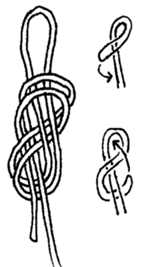
This is a very versatile knot most commonly used for attaching ropes to anchor
points. Most things that can be done with fancier knots (e.g. double loop
knots for a Y-belay) can also be done with a suitable combination of figure
of eights. If you only learn one knot, make it this one.
Strength: 55% (normal), 40% (abnormal)

The figure-of-nine knot can be used as an alternative to the figure-of-eight.
It is very similar to a figure-of-eight with just an extra turn before finishing the
knot. It is a little bulkier than the figure-of-eight but has greater strength.
Strength: 70% (normal), 55% (abnormal)
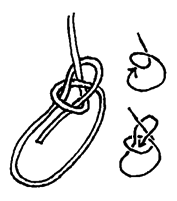
This can be used for tying a rope around a belay but is most often used for
tying the end of a safety line rope around a person when belaying them up
a climb or ladder.
This knot does have a tendency to loosen and can come undone so it
is a good idea to used a half hitch to secure the "tail" of the knot to the
loop.
Strength: 50% (normal)
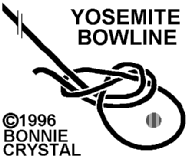
This knot was sent to me by Bonnie Crystal.
This is a variant of the basic bowline which gets around the problem of the
knot loosening itself by taking the end of the rope and threading it back
through the knot. This is a neat alternative to using a half-hitch to secure the
end of the rope and the resulting knot has the strength of a figure of eight.
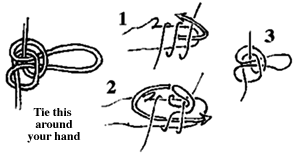
A good knot for rebelays or for tying rub points out of a rope. Its main
advantage is that the two strands of rope emerging from the knot
are at 180 degrees to one another rather than emerging in the same direction
as in a figure-of-eight for example. This makes it a good mid-rope knot and
good for rebelays because it has greater strength than a figure-of-eight if the rebelay fails.
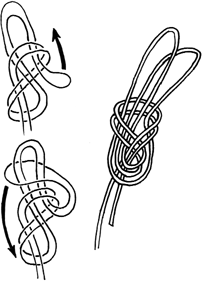
This double loop knot is most commonly used for rigging Y-belays. The nature
of the knot means that it is reasonably easy to adjust the loops by moving
rope from one of the
loops to the other.
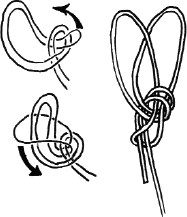
This is another double loop knot suitable for rigging Y-belays. It has the advantage
that is is a bit less bulky than the figure-of-eight on the bight.
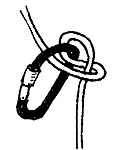
An excellent self-reversing friction knot suitable for belaying people
when climbing or using a ladder. It can also be used for abseiling and gives a smoother ride than
a stitcht plate (IMHO).
This one is worth learning for all those occasions when you
forget your Stitcht plate or descender.
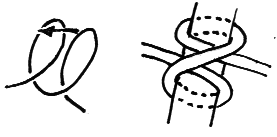
This simple knot is very useful for when you need a rapid belay around
an object or though a krab.
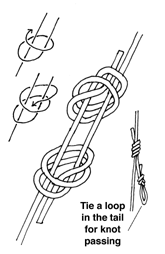
The standard knot for tying two ropes together. If used in the middle of a pitch,
a loop knot such as the figure-of-eight should be tied into one of the "tails"
of the knot for safety during knot passing.
The two knots that compose the double fisherman's should not be mirror
images of one another (i.e. they should have the same "handedness") otherwise
they won't stack properly.
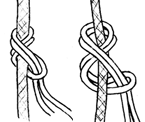
This knot was sent to me by Len Gibler
Leo says: "...this one as far as I can tell was invented and used
around 1960 by my friend Chet Hedden....It is possible to get it
to jam but it is easy to looosen and fair it."
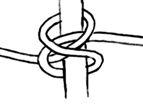
Th knot was sent to me by Len Gibler
Leo says: "A new knot useful to cavers and climbers was invented early this century
by Clarence Ashley himself. He calls it "the constrictor knot". It is enormously
resistant to coming undone. Ashley claims it can be used in a pinch as a radiator
hose-clamp and I don't doubt it..."
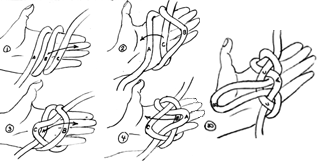
Th knot was sent to me by Len Gibler
Leo says: "This knot is excellent for tying in the middle of a climbing rope, for rebelays, for lashings of
many kinds -- anyplace a loop that leads fair both ways in wanted. The method for putting it in
is simplicity itself:
Take three turns of the rope round your hand, then:
1. Move center part (b) over right part.
2. Move new center part (c) over left part.
3. Move new center part (a) over right part.
4. Pull new center part (b) up to form the loop
5. For most satisfying results, remove hand before fairing or loading knot."
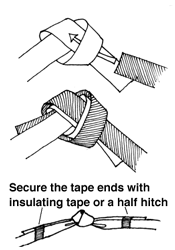
This knot is primarily used for tying tapes into slings for caving or climbing.
The ends of the tape emerging from the knot should be secured to the tape
loop using half hitches or insulating tape.
This knot is tied so that the load bearing tape emerges from opposite sides of the knot
so it will sit naturally when the sling is in use.
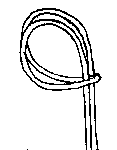
Often used for securing a tape more securely around a stalagmite or column.
The knot is weaker than just a loop of tape around the object, but it
reduces the chances of the tape slipping off.
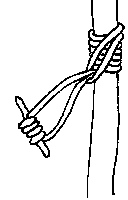
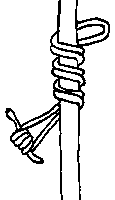
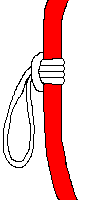
A classic prusik knot is shown on the left, and a Kleimheist prusik knot
on the right. Either of these, along with other prusik knots, can be used
to prusik up a rope. The rope used for the prusik-loop should
be a fair bit thinner than the rope to be climbed.
Sherry Mayo / ANU / scmayo@rschp2.anu.edu.au

















